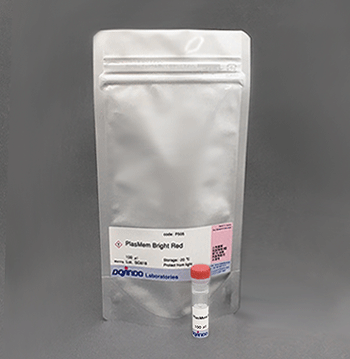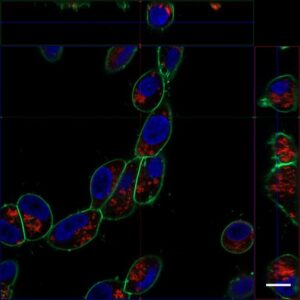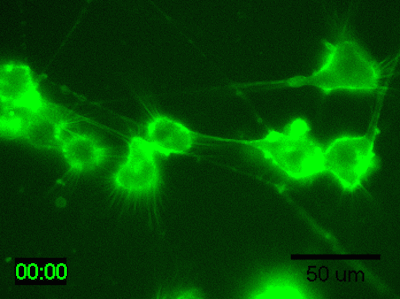PlasMem Bright Red

Cell Membrane Staining
- Applicable to live cells and fixation after staining
- High retentivity of reagents with low toxicity
- Just add reagents into medium
-
Product codeP505 PlasMem Bright Red
| Unit size | Price | Item Code |
|---|---|---|
| 100 ul | $288.00 | P505-10 |
The general number of usable assays per 100 μl
– 35mm dish x 10
– μ-Slide 8 well x 10
Description
The plasma membrane (PM), consists of a lipid bilayer separating the intracellular environment from the extracellular space. Consequently, the PM plays a central role in many cell behaviors, such as cell migration, cell stretching, and signaling cascades. Additionally, PM dysfunction is an important biomarker because it is related to the cell status and is linked to many diseases.
Dojindo’s PlasMem Bright dyes overcome these limitations. PlasMem Bright dyes are designed to stain PMs for over a day. Furthermore, the PlasMem Bright dyes are more water-soluble compared with other commercially available dyes and can be diluted with culture medium. The PlasMem Bright dyes offer two different color options (green and red) and are provided as ready-to-use DMSO solutions. A working solution can be prepared easily via a single dilution step using growth medium or HBSS.
Manual
Technical info

High retentivity on plasma membrane
HeLa cells stained with each plasma membrane staining reagent were incubated for 24 hrs and each the resulting fluorescent image was compared. PlasMem Bright series had higher retentivity on plasma membrane than other products.

Application Data: Observation of temperature-dependent changes in endocytosis of floating cells
The temperature-dependent changes in endocytosis of Jurkat cells were visualized using ECGreen-Endocytosis Detection (product code: E296) and PlasMem Bright Red.


(Scale bar: 10 µm)
<Experimental Conditions>
Endosome (ECGreen): Ex. 405 nm / Em. 500 - 560 nm
Cell membrane (PlasMem Bright Red): Ex. 561 nm / Em. 560 - 700 nm
<Genernal Protocol>
(1) Put Jurkat cell suspension (10% FBS, RPMI) in a sample tube and incubate at 4 °C or 37 °C for 30 min.
(2) Dilute EGreen solution (1000-fold) with the medium in step 1.
(3) Incubate at 4 °C or 37 °C for 30 min.
(4) Wash the cells twice with HBSS.
(5) Add medium containing PlasMem Bright Red (100-fold dilution) and suspend the cells.
(6) Transfer the suspension to an imaging plate and observe the cells using a confocal microscope.
Clear visualization of plasma membrane
Observe morphology of neuron (differentiated SH-SY5Y cells) and localization of mitochondria in axon.

Application Data: Mitochondrial detection in neuroblast (SH-SY5Y cells)
The neuroblasts SH-SY5Y cells were stained with PlasMem Bright Green (green), MitoBright LT Red (red) and Hoechst 33342 (blue), and 3D images were obtained with a confocal fluorescence microscope.

Detection condition
Plasma Membrane (PlasMem Bright Green, green): Ex. 488 nm / Em. 500 – 560 nm
Mitochondria (MitoBright LT Red, red): Ex. 561 nm / Em. 560 – 620 nm
Nuclear (Hoechst 33342, blue): Ex. 405 nm / Em. 400 – 450 nm
Protocol
(1) Wash SH-SY5Y cells with HBSS
(2) Add PlasMem Bright Green (diluted 200 times), Hoechst 33342 (final concentration: 5 µg / ml) and MitoBright LT Red (final concentration: 0.1 µmol / l) prepared in the medium.
(3) Incubate for 10 minutes
(4) Wash the cells twice with HBSS
(5) Observation with a fluorescence microscope
Application Data: Co-staining with exosomes
HeLa cells stained with PlasMem Bright Green were added with exosomes stained with the ExoSparkler Exosome Membrane labeling Kit-Red, and the uptake of exosomes into the cells was observed.
HeLa cells (Live cell)

HeLa cells (PFA fixed cells)

Detection conditions
Plasma Membrane (PlasMem Bright Green, green): Ex. 488 nm / Em. 500 –560 nm
Exosome (ExoSparkler Exosome Membrane Labeling Kit-Red, red): Ex. 561 nm / Em. 560 –620 nm
protocol
(1) HeLa cells and incubate for 24 hours
(2) Remove the supernatant and add PlasMem Bright Green (100-fold dilution) prepared in the medium.
(3) Incubate for 10 minutes
(4) Wash the cells 3 times with HBSS
(5) Add 175 μl of MEM medium and 25 ul of Exosome solution stained with ExoSparkler Exosome Membrane Labeling Kit-Red.
(6) Incubate overnight in a CO2 incubator
(For immobilization) Wash cells twice with HBSS, add 4% PFA, incubate for 15 minutes, then wash cells twice with HBSS
(7) Observed with a confocal laser scanning microscope
Application Data: Long-term imaging of brain-derived mouse neuroblastoma (N1E-115 cells)
Time-lapse imaging of N1E-115 cells stained with PlasMem Bright Green diluted 200-fold in medium for 30 min.

・ Cells: N1E-115 cells (brain-derived mouse neuroblastoma)
・ Medium: 5% FBS, 1% glutamine-containing D-MEM (Low-glucose)
・ Culture equipment: 35 mm glass bottom dish
・ Imaging equipment: Fluorescence microscope with incubator
・ Shooting time: 1 hour, shooting interval: 2 minutes
Data was kindly provided from Dr. K Fukui, Shibaura Institute of Technology.
Application Data: Macrophage cells uptake exosome
Human gingival tissue-derived mesenchymal stem cell (GMSC)-derived exosomes were isolated using MagCapture™ Exosome Isolation Kit PS (Fujifilm Wako Pure Chemicals Co., Ltd.) and stained with ExoSparkler Exosome Membrane Labeling Kit-Green (code: EX01) and then added to human macrophage cells differentiated from human peripheral blood mononuclear cells (PBMC), and the macrophage cells were stained with PlasMem Bright Red.
(The data is kindly provided by Dr. Takao Fukuda, Division of Oral Rehabilitation, Fukuoka University)

<Experimental Conditions>
Exosome (Mem Dye - Green): Ex 488 nm / Em 490 - 540 nm
Cell Membrane (PlasMem Bright Red): Ex. 561 nm / Em. 560 - 700 nm
Nuclei (DAPI) Blue: Ex. 345 nm / Em. 455 nm
<General Protocol>
1. Induce differentiation of PBMC-Mf on Poly-L-Lysine coated slide on 24 well plates (7days)
2. 10 µg of exosomes were stained according to the protocol of ExoSparkler Exosome Membrane Labeling Kit-Green.
3. Add 1 µg/mL of exosomes to a 24 well plate and incubate for 3h.
4. Wash once with PBS.
5. Add PlasMem Bright Red (1/100 diluted with medium), incubate in a CO2 incubator for 15 min.
6. Wash three times with PBS.
7. Fix with 4% PFA for 15 min at room temperature.
8. Wash three times with PBS.
9. Mount with containing mountant (Invitrogen: ProLong™ Gold Antifade Mountant with DAPI).
10. Observe with LSM 700 confocal microscope (Carl Zeiss).
Excitation and emission spectra of PlasMem Bright dyes

References
| No. | Sample | Instrument | Reference (Link) |
|---|---|---|---|
| 1) | Cell (Macrophage) |
Fluorescence microscope |
Y. Nakao, T. Fukuda, Q. Zhang, T. Sanui, T. Shinjo, X. Kou, C. Chen, D. Liu, Y. Watanabe, C. Hayashi, H. Yamato, K. Yotsumoto, U. Tanaka, T. Taketomi, T. Uchiumi, A. D. Le, S. Shi, F. Nishiura, "Exosomes from TNF-α-treated human gingiva-derived MSCs enhance M2 macrophage polarization and inhibit periodontal bone loss", Acta Biomater., 2020, doi:10.1016/j.actbio.2020.12.046. |
| 2) | Cell (HeLa) |
Fluorescence microscope |
K. Qiu, R. Seino, G. Han, M. Ishiyama, Y. Ueno, Z. Tian, Y. Sun, J. Diao, "De Novo Design of A Membrane-Anchored Probe for Multidimensional Quantification of Endocytic Dynamics", Adv. Healthcare Mater., 2022, doi:10.1002/adhm.202102185. |
Q & A
-
Q
Can I fix the cells?
-
A
Fix cells with 4% PFA is possible.
However, do not use cell permeabilization reagents which may cause loss of fluorescence.
-
Q
Is it possible for long-term fluorescent observation?
-
A
It is possible.
However, please try to keep the excitation to the minimum amount. Exposure of cells to excitation light may cause cell damage and degradation of the dye, optimizing the factors such as interval time.
-
Q
When preparing the working solution, is it possible to dilute it with serum-free medium or buffer?
-
A
Yes, it is possible to prepare the working solution with serum-free medium or buffer.
-
Q
What should I use to wash the cells after staining?
-
A
Serum-free medium or buffers like PBS and HBSS can be used for washing the cells after staining.
-
Q
After adding the working solution, is it possible to observe the fluorescence immediately?
-
A
Yes, it is possible to immediately observe the fluorescence after adding the working solution. According to the protocol, it is recommended to add the reagent and incubate for 5 minutes before observation.
-
Q
It seems like some place other than cell membrane has been stained. What is the possible reasons?
-
A
There are two possible reasons:
1 Some of the reagents retained in the cell membrane are taken up into the cell by endocytosis over time.
(Please refer to the figure in "Technical Info: High retentivity on plasma membrane" on this page.)2 If the focus is at the bottom of the cells (adhesive surface) the image may be observed as Fig. A.
Please try to adjust the height of the Z-axis as shown in Fig. B
-1.jpg)
-2.jpg)
-
Q
There are precipitates in PlasMem Bright Red solution, could I still use it?
-
A
Yes, no problem.
If there are precipitates in PlasMem Bright Red solution, just warm the tube to 37℃, the solution should be clear again.
-
Q
Can I co-culture the cells stained with PlasMem Bright Green and the cells stained with PlasMem Bright Red to tell them apart?
-
A
When the cells come into contact with each other, the PlasMem dye moves to the other cells, so it cannot be told apart.
Handling and storage condition
| Appearance: | Red purple liquid |
|---|---|
| Dye content: | To pass test |
| -20°C, Protect from light | |
|
Danger / harmful symbol mark |

|
|---|---|


















